Dig Dug
19 April 1982 (Arcade, JP)
Taizo Hori, aka Dig Douglas, is the canonical father of Mr. Driller. Give the choice between Mr. Driller’s adventures and his father’s first outing, I’m team Driller every day of the week. I’ve never quite gotten the flow of Dig Dug down to a point where I can get much past the first four or so levels. The game nevertheless represents the boldest stylistic step to date by Namco, who at this point were nearing the second anniversary of their landmark Pac-Man. Those two years saw exploration of themes such as driving in terrible mazes, shooting at aliens as a man, shooting at balloons as two men, shooting at aliens, and even the famous “shooting at ships as a ship” subgenre of games. With Dig Dug, we get a foray into new territory: a game where everything is cute.
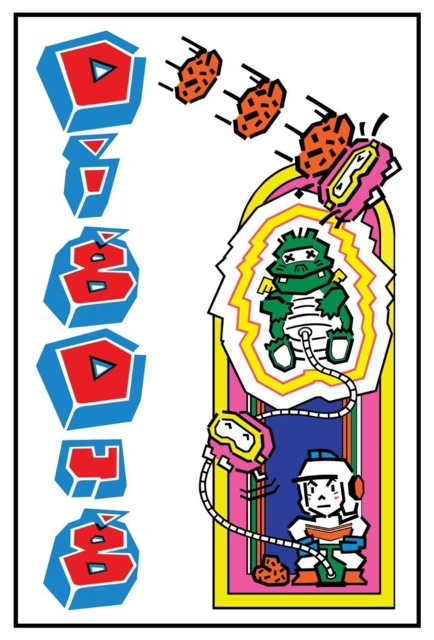
Certainly Namco had dabbled with oppressively cute design over the years. From the walking bonus target in Cutie Q to the simple designs of Pac-Man, and even the aliens in the obscure Warp & Warp, Namco’s in-house designers had conjured a few adorable character designs. But where these games would insert charming elements into otherwise standard arcade fare, Dig Dug is positively larded with cuteness. Taizo Hori himself is represented by a properly chibi sprite (never mind his dollar store Speed Racer getup on cabinet art), and programmers Fukatani Shouichi and Sakai Toshio pulled off a masterstroke by linking Keino Yuriko’s score to Hori’s movement. This playful music serves to make navigating subterranean tunnels feel far more lighthearted than the grim reality of the game.
I say grim, as this is a game about crushing cute little ball people to death with rocks or, in a truly grisly twist, forcefully pumping them full of air until they violent rupture and pain the walls of their dark cavernous homes with blood. Alright, so I’ve exaggerated the blood, but that’s an apt description of the game flow. Score points by digging terrain and killing monsters, all the while they pursue you via insubstantiating themselves and phasing through the ground in your direction. The Pookas, with their outsized goggles and armless Kirby silhouettes, make for adorable but persistent opponents. The Fygars are generally fewer in number, but come with the added ability to breath fire (through, as it turns out, the narrow slice of compacted earth between two tunnels). Slaughter the entire level’s assembly of baddies and move on to the next. Even here, a cute touch is added: rather than use the epaulettes and badges of Galaga to demarcate your progress, Dig Dug adds flowers to the top of the playfield (again, fertilized by the blood splattered about by the ruthless Taizo Hori).
Dig Dug is a very good arcade game, but as I mentioned above I remain fairly rubbish at it. I tend to go hard on trying to drop boulders on enemies for points, but often wind up getting cornered or hoisting myself on my own petard in a self-crushing accident. I do feel it says a lot for the game that, even in throwing myself at the same few levels in vain, it still manages to be a pleasurable experience. It has that difficult to quantify “game feel” that Namco had demonstrated an almost preternatural capacity to imbue into its finest works. Programming work for this title is credited in part to Fukatani Shouichi, whose work we have seen in prior titles like Cutie Q, King & Balloon, and Warp & Warp. Sadly, this was one of his last works. Fukatani passed away in mid-1985, in the midst of working on a few of Namco’s Famicom titles. He received posthumous credits for programming work on Warpman, and was still special thanks credits two years after his passing. These credits referred to him as a great programmer and went so far as to call him a master. Clearly Fukatani was beloved by his compatriots at Namco, and Dig Dug was arguably his finest hour.
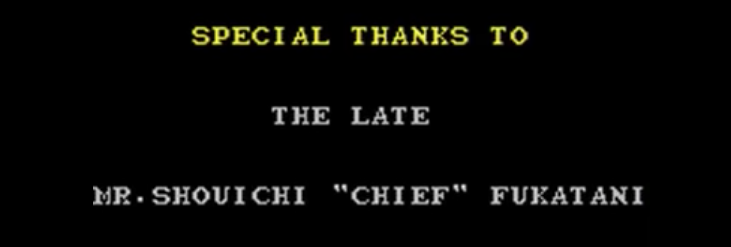
With that, let us turn to the the ports. No microcomputers this time around, though Dig Dug made the rounds on those platforms. In fact, this was a fairly well documented game on the Giant Bomb Wiki before I showed up. I’m mostly filling in some holes and providing more solid dates where needed.
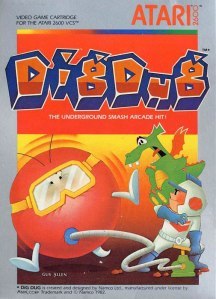
Dig Dug went three for three on numbered Atari home consoles, having been bundled into the same licensing agreement as Pac-Man, Galaga, and other existing Namco titles in 1982. The first port of call was the VCS, which by October 1983 had already entered Video Game Crash mode. It had also entered obsolescence when held against the standards of the ColecoVision in North America (and the Famicom overseas), but that didn’t stop Atari Corporation from supporting the platform with first party titles until 19-holy-shit-are-you-kidding-me-90. Dig Dug for the 2600 is so far the best conversion to that platform that I’ve seen in this project. The arcade graphics are redrawn to meet the limited hardware spec of the system, but everything is communicated in a simple enough visual language that the screen “reads” about as well as one could hope. The playfield is squished vertically fit a television screen, the instrumentation is stripped down to the barest essentials, and the Fygars look a bit like poop emojis with snake emoji faces. But what’s left is undeniably Dig Dug.
After a bit of digging, it turns out that Dig Dug on the 2600 was programmed by Doug Macrae. Who was Doug Macrae? Well, he was a developer at General Computer Corporation who helped sire a little game called Ms. Pac-Man. GCC had been essentially forced into slave labor by Atari as the result of a lawsuit over them distributing conversion kits for Atari arcade titles, Missile Attack being the main focus. We’ll be speaking more about GCC, Macrae, and Ms. Pac-Man in the near future.
Up next we have the ill-fated Atari 5200 conversion of Dig Dug, released in the same month as the 2600 version on the year old and floundering 5200 platform. I’m mixed on this port. The art certainly adheres more closely to the arcade original, but it enters maybe the first instance of “uncanny valley” quality in the NamCompendium. The 2600 version felt like art from adversity (technical adversity), whereas this just looks and sounds like a bad simulacrum of the genuine article. Even the more capable sound hardware of the 5200 is wasted here, rendering the original background music on what sounds like gross carnival music. General Computer Corporation were responsible for this port, and while they did manage to get things right on paper (right down to the flowers at the top of the screen), I’d take the 2600 conversion over this.
The next close near to solid date is the June 1984 test market release of the 7800 port, plagued by the same sordid release history as Galaga which I covered two issues prior. That is to say, this game had a second “official” release in late 1986 after Tremeil’s Atari Corporation deigned to release their stock of mothballed 7800 consoles. This was another General Computer Corporation port, and the first thing that leaps out is the nearly identical music to the 2600 port. This is owed to both systems sharing fundamentally the same sound hardware, because the hell if mid-80s Atari were going to spend one more penny than absolutely necessary. Otherwise we’ve taken strides here in becoming much closer to the arcade original’s color palette and sprites. The game feels a little cramped, moreso than the versions already covered, perhaps due to hewing ever closer to Namco’s original aesthetics while retaining the same squashed aspect ratio. This is hardly a bad version, certainly better than Galaga on the same platform in terms of “game feel” and faithfulness to the source, but I’d still go with the 2600 version if you must play one of these Atari ports. Making Dig Dug run on a mid-80s console is simply not as impressive as having it run well on hardware as old as Star Wars.
In the same year, AtariSoft had sought to release a port of Dig Dug for the competing ColecoVision. It exists on the Internet in a mostly playable form, and it’s grisly. This is somehow the first version that couldn’t pull off syncing the music to Hori’s movement, features a muted color palette, and some baffling sprite flickering business. It also moves slower than other versions covered herein. Wise move to have shitcanned this version.
About two years after the release of the Famicom in Japan, Namco graced that platform with its first in-house developed port of Dig Dug. This June 1985 number continues the trend of Namco’s in-house conversions for the Famicom entering the market as the best versions available. Namco continued their line of bespoke numbered games here, giving this release the designation “06” on the box art and cartridge.This version suffers from the same aspect ratio constraint of the other 8-bit ports, features the same concession of moving score and HUD-esque information to one vertical column on the right as Famicom Pac-Man and Galaga, and the platform’s bespoke not-really-RBG color space leads to a more muted color selection. There’s also the strange decision go use a black sky instead of the arcade’s blue, perhaps making this the only version of Dig Dug that takes place at night? Those alterations excluded, this is arcade-ass Dig Dug presented as best as it could have been in 1985. It was sound enough that this was yet another of these early ports to receive a second release on the Famicom Disk System format, this time on 20 July 1990.
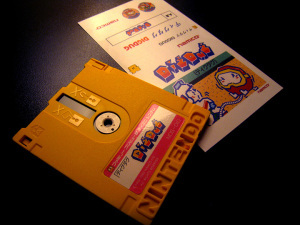
The mid-1985 release of Dig Dug was a few months out from the North American test launch of the Nintendo Entertainment System. It might have made a nice early release for the system, rounding out a roster of action games with a bit of classic arcade flavor. That did not happen. In fact, Dig Dug never came to the NES. This could be seen as an anomaly, but that would be to omit a larger trend: a lot of Namco’s first party Famicom output never crossed the Pacific. By my best estimation Namco published 86 titles on Nintendo’s home console in Japan between 1984 and 1993. Eight of those were released in the United States, less than one tenth of their output. This could be chalked up to the lack of a Namco office established to handle publishing and distribution of home console games in North America in this period, or their reliance on Atari Games (via Tengen) for distribution, or Namco President Nakamura Masaya’s very public shit talking of Nintendo President Yamauchi Hiroshi in Japan at this period. Likely it was some combination of all three. Regardless, the eight games released in NES gray cartridges (starting with Hudson’s publishing of Sky Kid in late 1987) did not include Dig Dug. This seems fairly odd when one considers the lasting influence Dig Dug has had on people. It remains one of the most popular games in the company’s back catalog, and they’ve certainly managed to keep it circulated since this period. A strange gap nonetheless.
If you thought we were done with Atari here, you might want to sit down. This one’s a bit crazy. AtariSoft, the sub-label founded by Atari Incorporated that handled development of Atari titles for non-Atari platforms (comprised of individuals who were alleged to have taken trade secrets from Mattel along with them when they joined the company) developed a take on Dig Dug for the Intellivision. Then the sale and division of Atari occurred, and in 1984 this game went into deep freeze. Through a process obscured by time, INTV Corporation wound up negotiating a deal with then Atari Corproation which granted them permission to release this title three years later. Mark Kennedy, a former Mattel employee, passed along a build of the game to Dave Warhol of Realtime Associates. Said company polished up the game, and Dig Dug was finally released for Intellivision around Q2 1987.
What did all of this torturous three year handing off of prototype code and repolishing net us, fans of vintage video games from thirty years yon? Basically, the 5200 version of Dig Dug once more. Same off-tune carnival organ rendition of the music, comparable visuals, stretched aspect ratio. It is a playable version of the game, but not one to be recommended over its contemporaries.
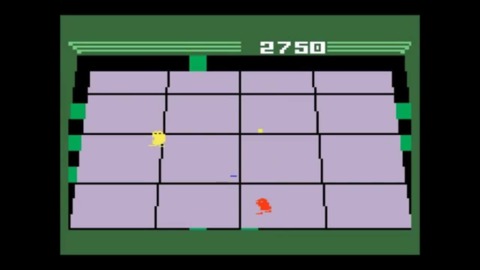
There is, however, the matter of the second entire goddamn game included on the cartridge. As Dave Warhol began to develop tools to build games for the Intellivision, he began to fiddle around with an essentially cracked version of TRON Deadly Discs. His modification to the game was to use the hot dog sprites from Intellivision BurgerTime. He was so fond of this little demo that, upon discovering that the Dig Dug cartridge had enough left over space in memory, he decided to cram his Deadly Discs facsimile alongside it. If you *ahem* definitely place your very real physical copy of Dig Dug into your very real and legitimate Intellivision, press 4 and 7 on both controllers simultaneously and press reset, you’ll be taken to an entirely different game: Deadly Dogs! by Dave Warhol. This is actually an alright little goof of a game, features surprisingly good sound, and its inclusion on the cartridge makes Dig Dug for the Intellivision worth a consideration for your collection just on the novelty factor. It also elevates it well clear of the 5200 version.
The last standalone physical release for consideration is the Game Boy release, which arrived in North America in September 1992. As a sort of cosmic quid pro quo, this standalone port never found its way onto Japanese store shelves despite having been developed there. This is actually the first appearance of developer Now Production in the NamCompendium. The company began working with Namco around 1986, with their first credit being the Famicom conversion of Metro-Cross. Now Productions would wind up developing at least seven Famicom games for Namco, and would eventually send the console into its officially ordained long night with 1994’s Takahashi Meijin no Boku Jima IV
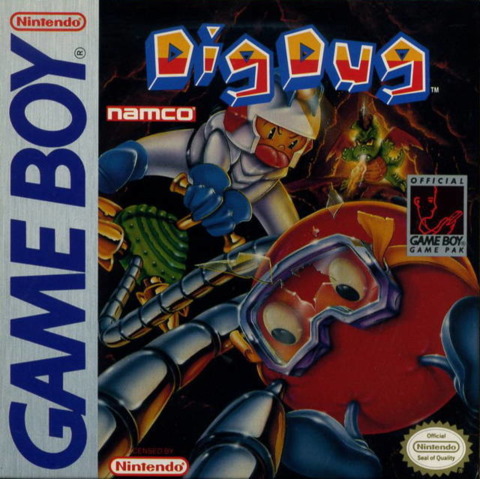
Not content to simply retreat ground, Now Production pulled a similar trick to the aforementioned Dave Warhol and crammed two games onto this cartridge. There is Dig Dug, and now New Dig Dug. To tackle these in order, let’s start with the original. This is a slower playing version of arcade Dig Dug that feels like it really taxes the Game Boy. The music does not come off particularly well, and obviously the vibrant colors of the CRT original are long gone here. You do get what feels like an attempt to recreate the original portrait aspect of OG Dig Dug, but it comes with a major caveat that impacts both versions on this cartridge: your view is confined to a 10×8 tile window that moves along with Taizo Hori. I’m no expert, but Dig Dug play almost requires a full view of the play field at all times. Perhaps even more so than Pac-Man’s portable ports, this is a severely detrimental accommodation to the format and makes Dig Dug in its arcade mode pretty damn dire.
New Dig Dug manages to make a better show here, but not without its own issues. Here the game switches from a score attack game built around scores, to a sort of explorative digging game with the goal of collecting keys to unlock a door. The subterranean worlds now feature unbreakable black squares of terrain, giant spheres that roll on flat ground and drop down chasms, and bombs that explode upon reaching the bottom of a well. This winds up being much more of an attraction than the base game, but still suffers from the same cramped screen real estate as mentioned above. It would be neat to see this idea fleshed out elsewhere, as a sort of Dig Dug Arrangement even, but this seems to be the only place to get your hands on New Dig Dug.
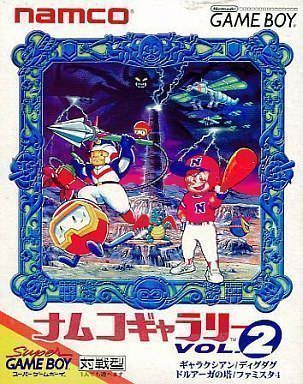
All of this is not to say that there was never a version of Dig Dig released for the Game Boy in Japan. That, too, would undersell the madness of the NamCompendium. Dig Dug appeared amidst the earliest stirrings of Namco’s broad initiative to monetize its back catalog, which began in the mid-90s and shall continue until we are all but dust. Specifically, the TOSE-developedNamco Gallery Volume 2 compilation features what seems like an exact dump of Now Production’s Game Boy port of Dig Dug. Released 29 November 1996, this stealthy re-release of Dig Dug is nestled onto a single cartridge alongside Galaxian (which I really should mention in NamCompendium 1), The Tower of Druaga, and Famista 4*.
1996 wound up being quite the year for Dig Dug, as wound up resurfacing in three places by the time 1997 arrived. The first of these was in Namco Classic Collection Volume 2, a compilation arcade cabinet that launched in March. This series, as a refresher, included both the original arcade iterations of select Namco titles (in this case, Dig Dug was packaged with the excellent Pac-Man and the bag of old turds that is Rally-X) and “Arrangement” versions of said games. Dig Dug’s Arranged mode, like the others in this series, amounts to a slightly tweaked spin on the original with changes including different enemy placement, the occasional larger boulder to drop, garish new music and graphics, and two player simultaneous play. This Dig Dug Arrangement resurfaced on the PS2, Xbox, and GameCube releases of Namco Museum, and is not to be confused with the eponymous Dig Dug Arrangement that was included on Namco Museum Battle Collection (PSP, 2005) or Namco Museum: Virtual Arcade (360, 2008).
Speaking of which, it was Dig Dug’s turn to enter into the Namco Museum label on 21 June 1996, when it was packaged into the Japanese release of Namco Museum Volume 3 for the PlayStation. This was the volume which also included Galaxian and Ms. Pac-Man, fine company for the game.
The compilations did not end after 1996. Dig Dug is one of the true perennials of Namco’s backlog, and has appeared in the following not-previously-mentioned releases as well:
- Namco Museum 64 (N64, 1999)
- Namco Museum (DC, 20005; GBA 2001**, PS2 2001, XBOX and GCN 2002)
- Namco Museum (PSP, 2005 [JP]])
- Namco Museum Battle Collection (PSP, 2005 [NA])
- Namco Museum 50th Anniversary (PS2, XBOX, GCN, GBA, 2005)
- Namco Museum Remix (Wii, 2007)
- Namco Museum Essentials (PS3, 2009)
- Namco Museum Megamix (Wii, 2010)
- Pac-Man’s Arcade Party (Arcade, 2010)***
- Namco Museum (Switch, 2017)
In the intervening years, Dig Dug received digital releases outside of its compilation milieu. First was the North American release of the Famicom Dig Dug, which came to the Wii Virtual Console on 9 June 2008 with the import price of 600 Wii Simoleans. This version came out a month later on the Japanese Virtual Console, and was followed on 20 October 2009 with the arcade version of Dig Dug’s release on Japanese Virtual Console. The Famicom Dig Dug was also added to the 3DS Virtual Console (14 February 2013) and Wii U Virtual Console (5 February 2015). Such is the enduring popularity of Dig Dug that it is one of three classic Namco arcade games available as a standalone digital purchase on Xbox Live and the PlayStation Network for the Xbox One and PlayStation 4 respectively, both released on 20 April 2016. Surely, Taizo Hori was blazed as hell on that blessed day.
The only two major platforms to not receive some compiled version of the game since the year 2000 were the Nintendo DS, the 3DS, and the PlayStation Vita. The DS makes up for this by being backwards compatible (prior to the DSi) with two GBA titles that feature Dig Dug. The 3DS has the Virtual Console release, and the Vita is digitally backwards compatible with NaMuVo3 through PSN. In other words, if you have a video game console manufactured after 1999, you can play Dig Dug.
Despite my many opportunities to play and improve upon my own meager skills at the title in the process of writing this entry, I remain quite poor at Dig Dug. I have made peace with this reality, as in fact I am not great at a lot of video games. One of my crowing achievements thus far in the NamCompendium was having a modestly high score stay on a nearby Galaga machine for a few weeks (before the machine itself disappeared from the back corner in which it resided). Mine is but to document these things.
Unfortunately, one of the true bastards of this documentary effort is now up at plate and can be set aside no longer. The next entry in the NamCompendium, which may or not also be the first NamCompendium Gaiden, shall cover Ms. Pac-Man. Following that, we will have a look at three more Bally Midway joints that took the Pac-Man likeness and slapped it onto some games that are all but completely forgotten. Until then, keep on brutally murdering spherical monsters with air pumps.
<- Take me back to the NamCompendium
********************
*Not to be confused with the fourth Famista release on any of the billion goddamn systems that series infected. Please do not talk to me about Famista. I will talk about Famista when I am good and goddamn ready to talk about Famista. Do not say the word “Famista” in my presence.
**Next Generation, a now defunct video games press outlet, published that as of 2007, Namco Museum for the GBA was third best selling game on the platform to that point with 2.4 million units sold. They stated it was outsold by only Pokemon Ruby and Super Mario Advance 2: Super Mario World. I struggle to believe this, and they even poke holes in their own ranked list (they admit to culling multiple other Super Mario Advance titles and state that combined Pokemon as a franchise sold nearly ten million units), but that’s still a pretty wild number.
***I just learned of the existence of this machine. It’s a multi-game cabinet, release information is sketchy, and it includes games already covered in this project. Great stuff.

Log in to comment